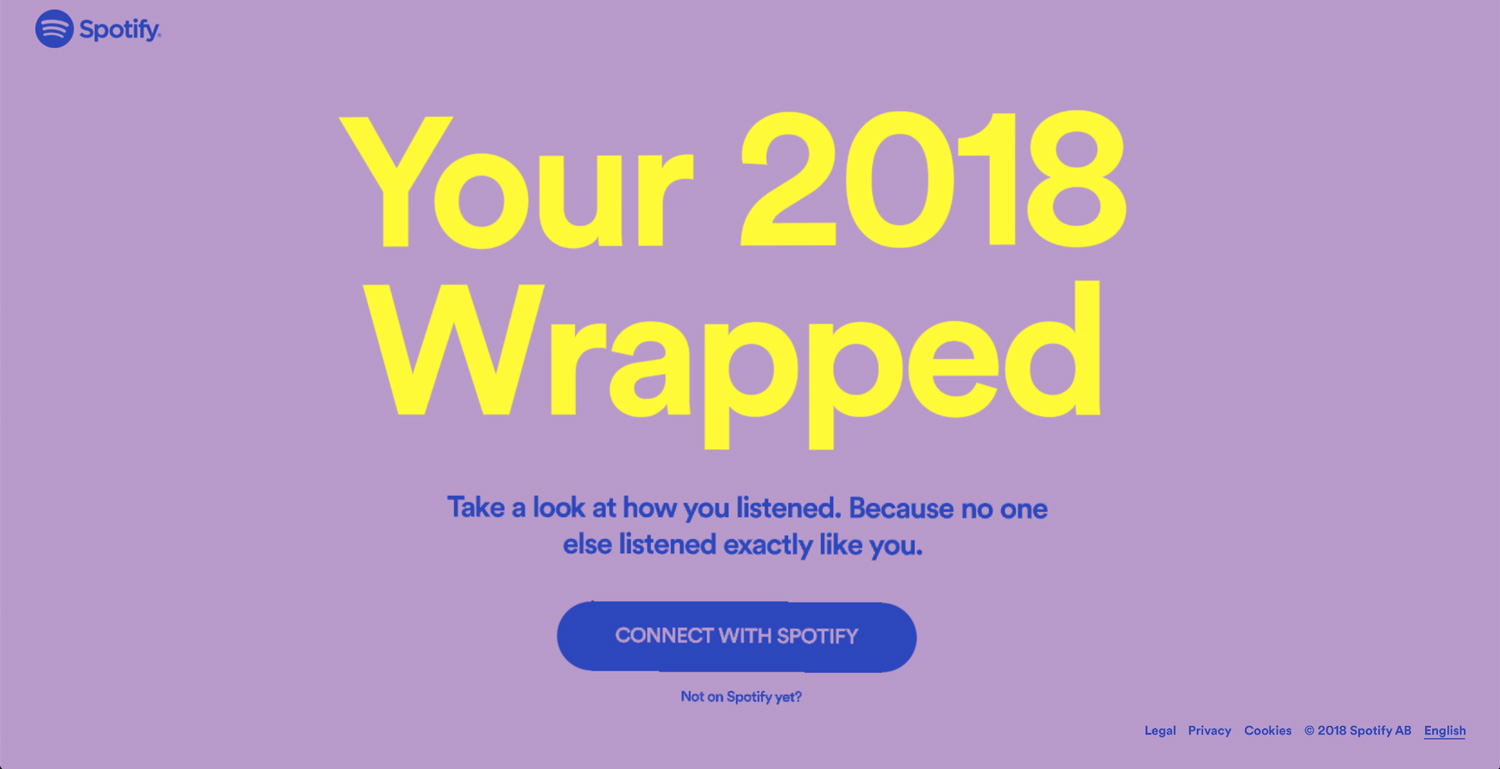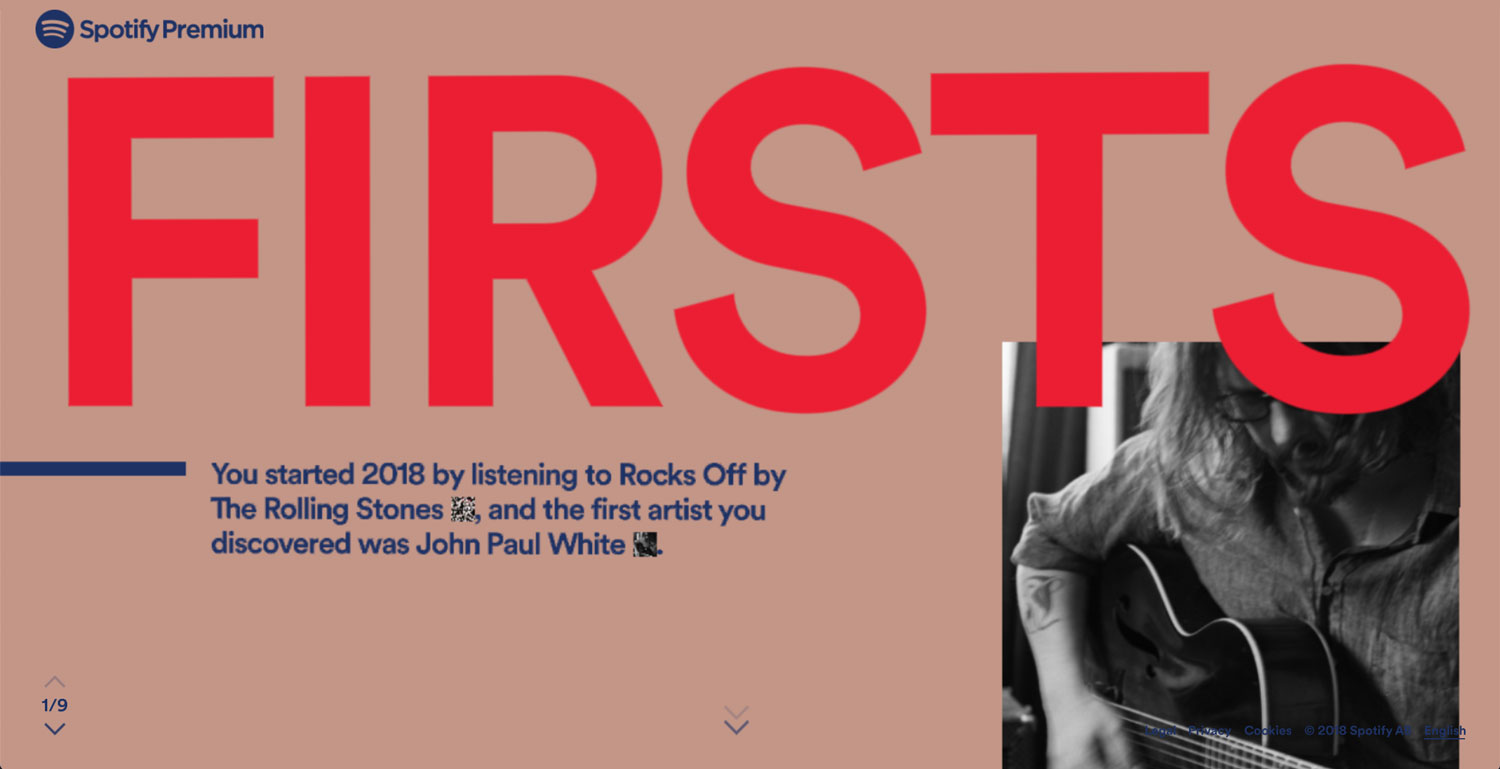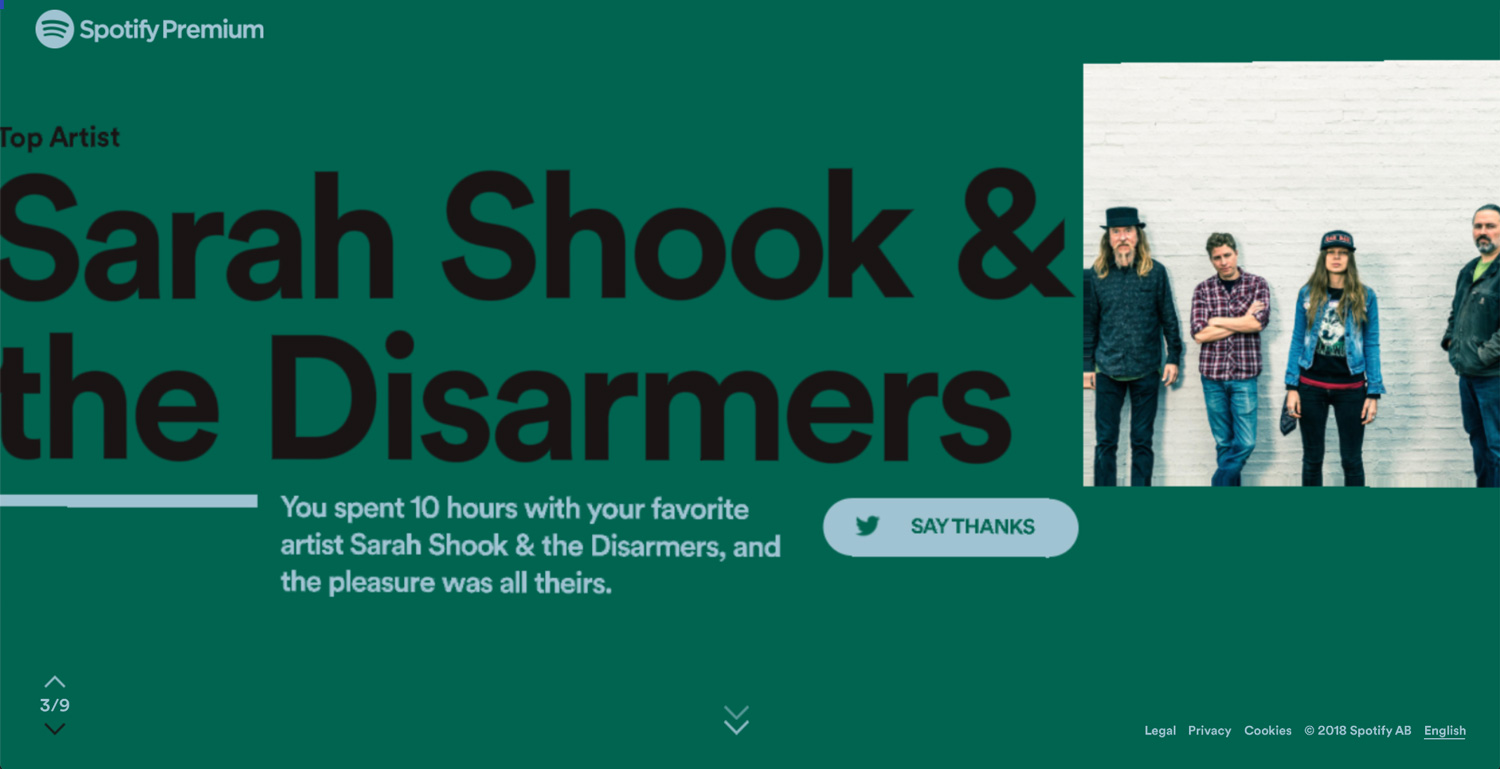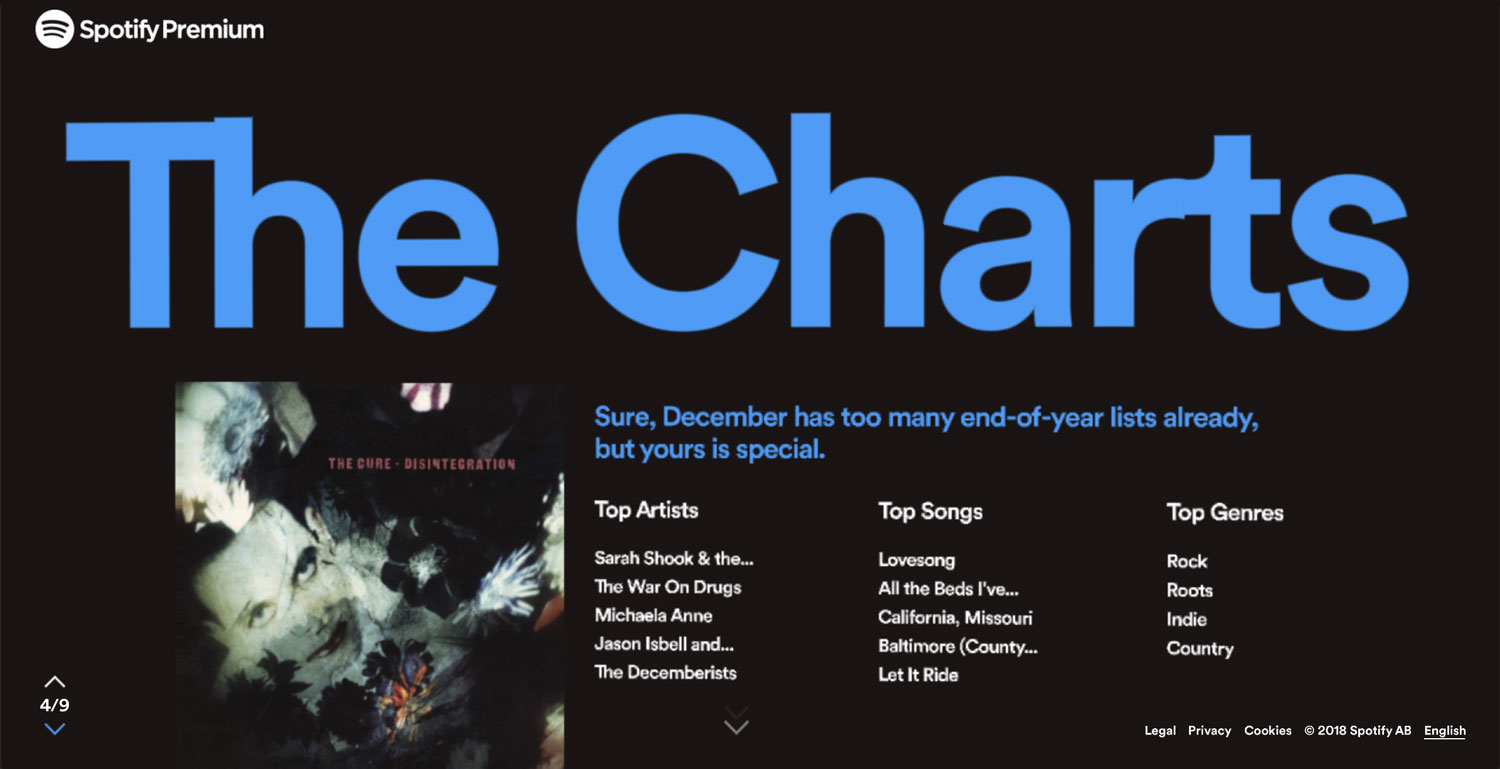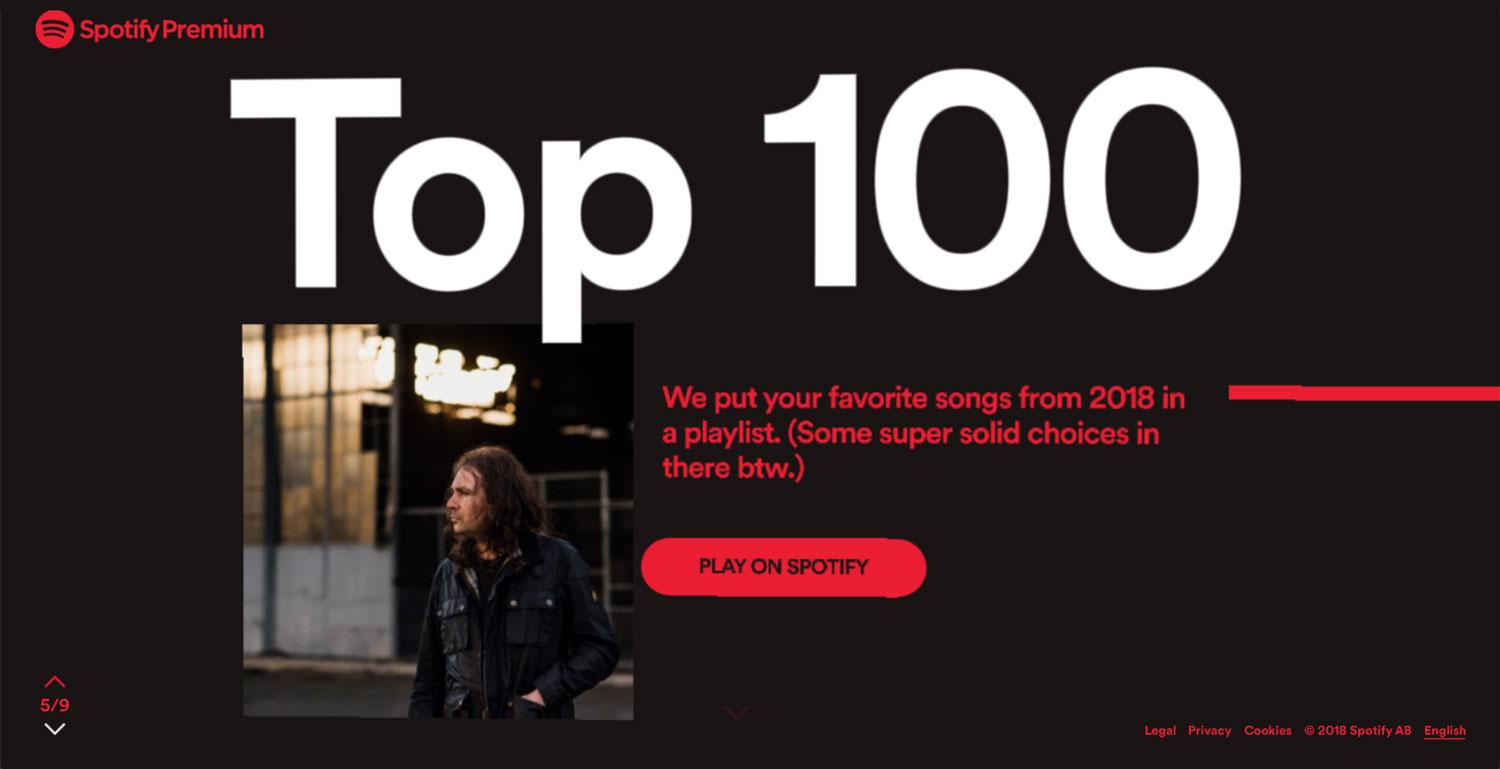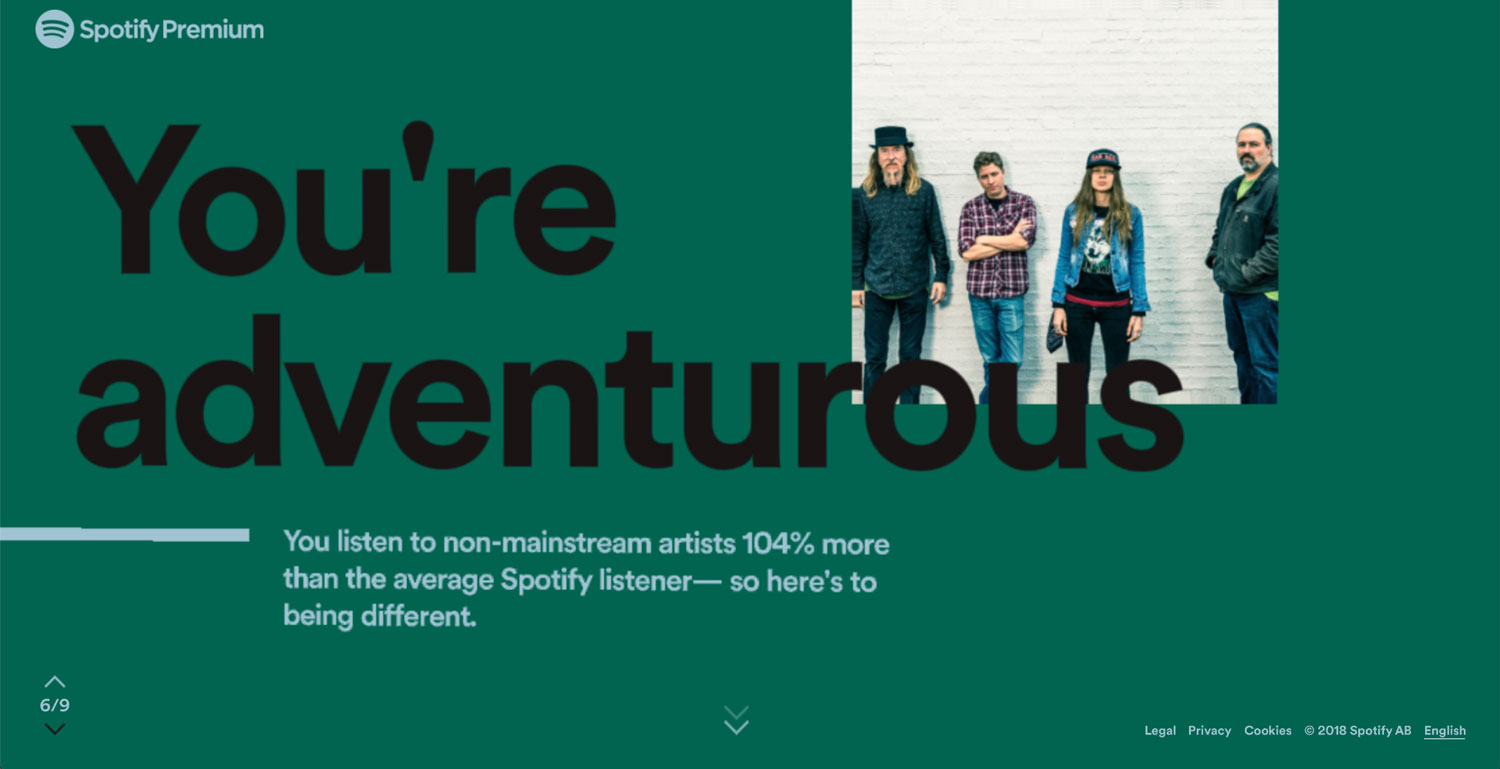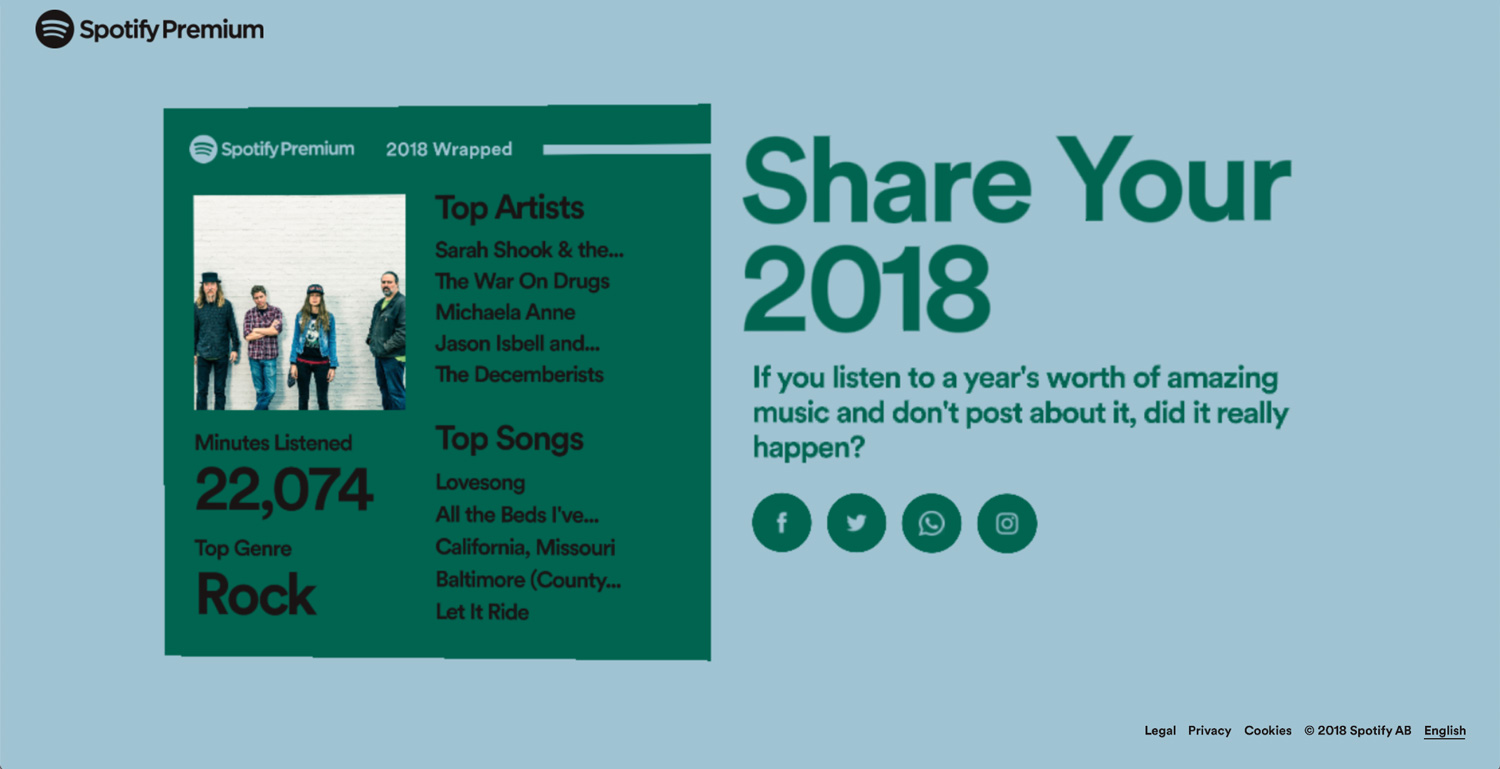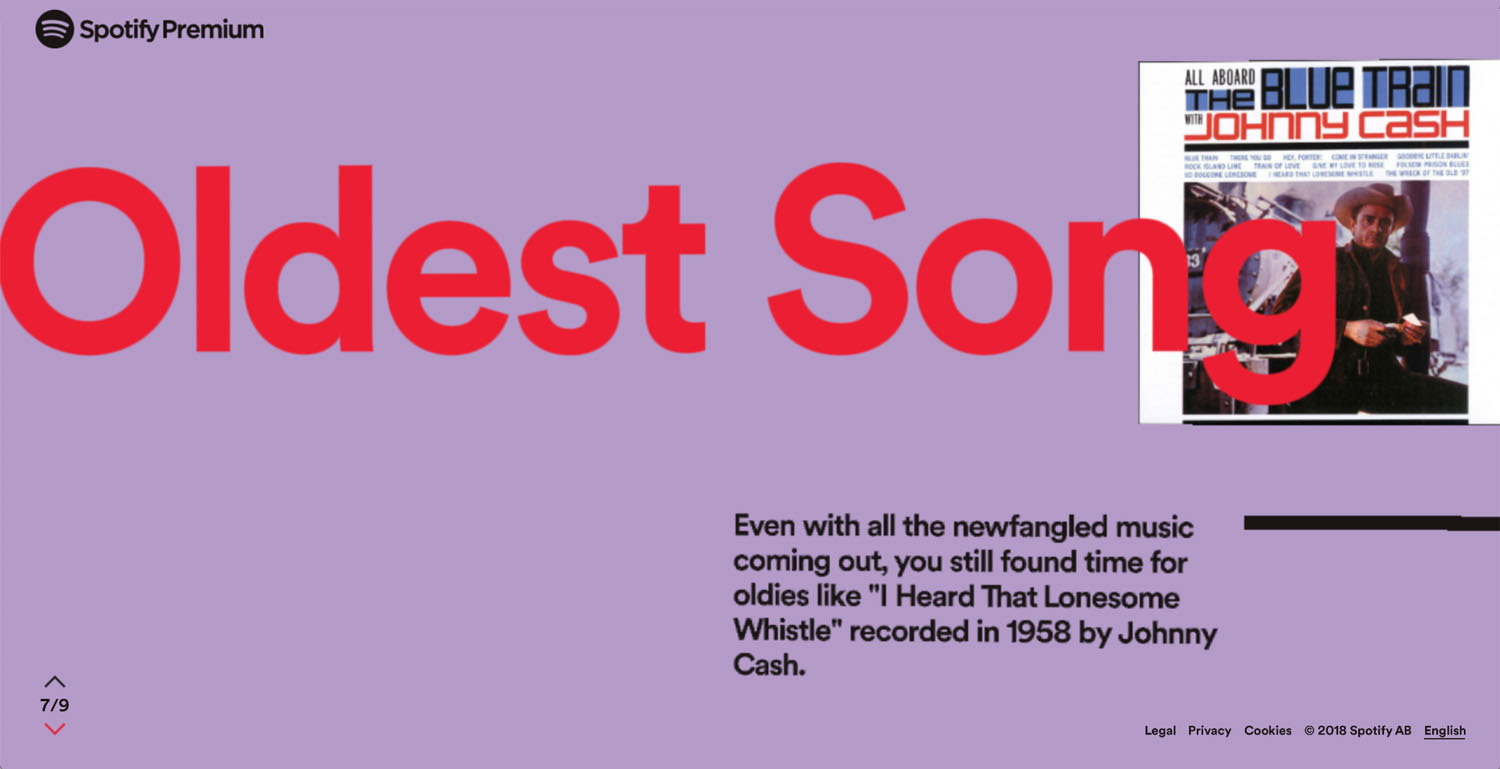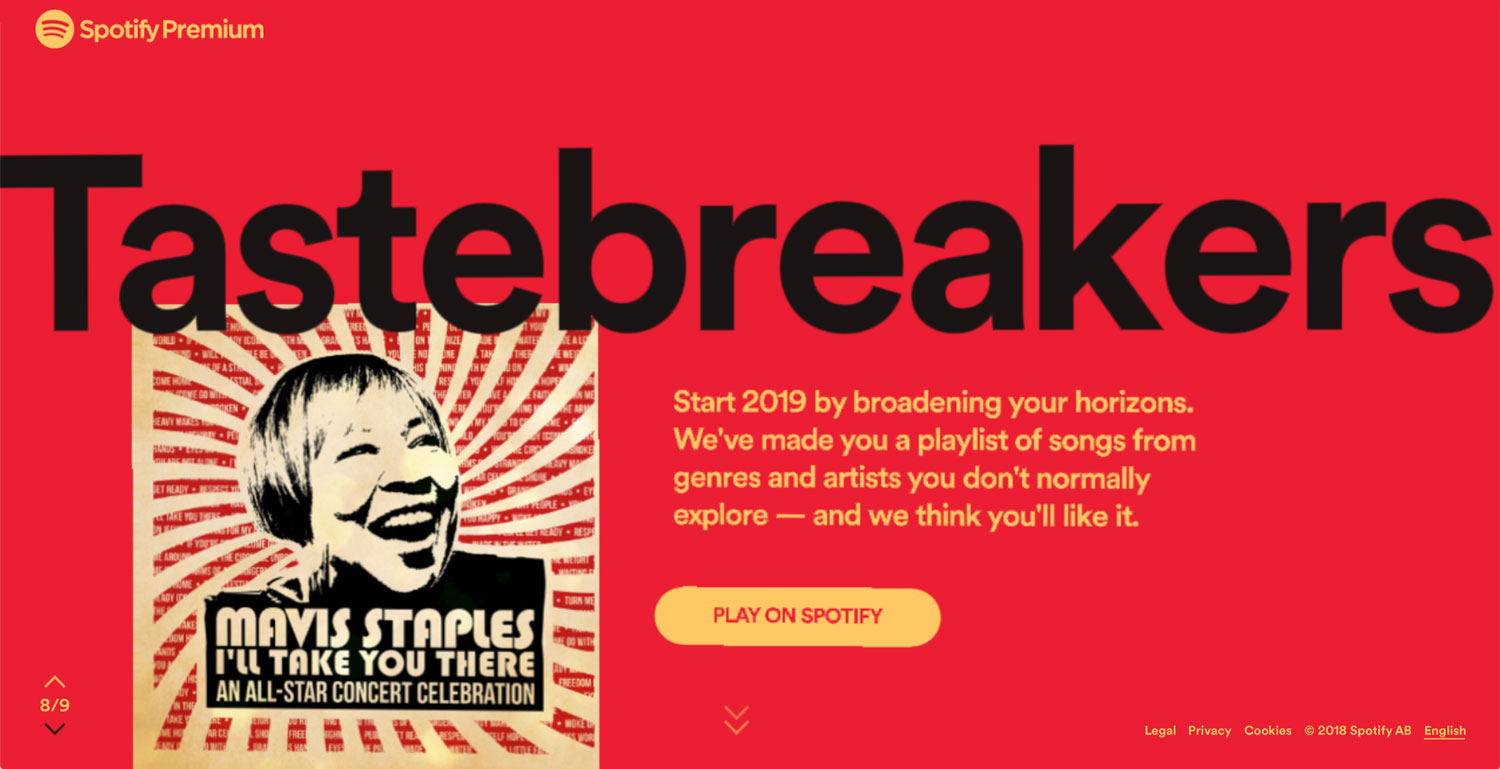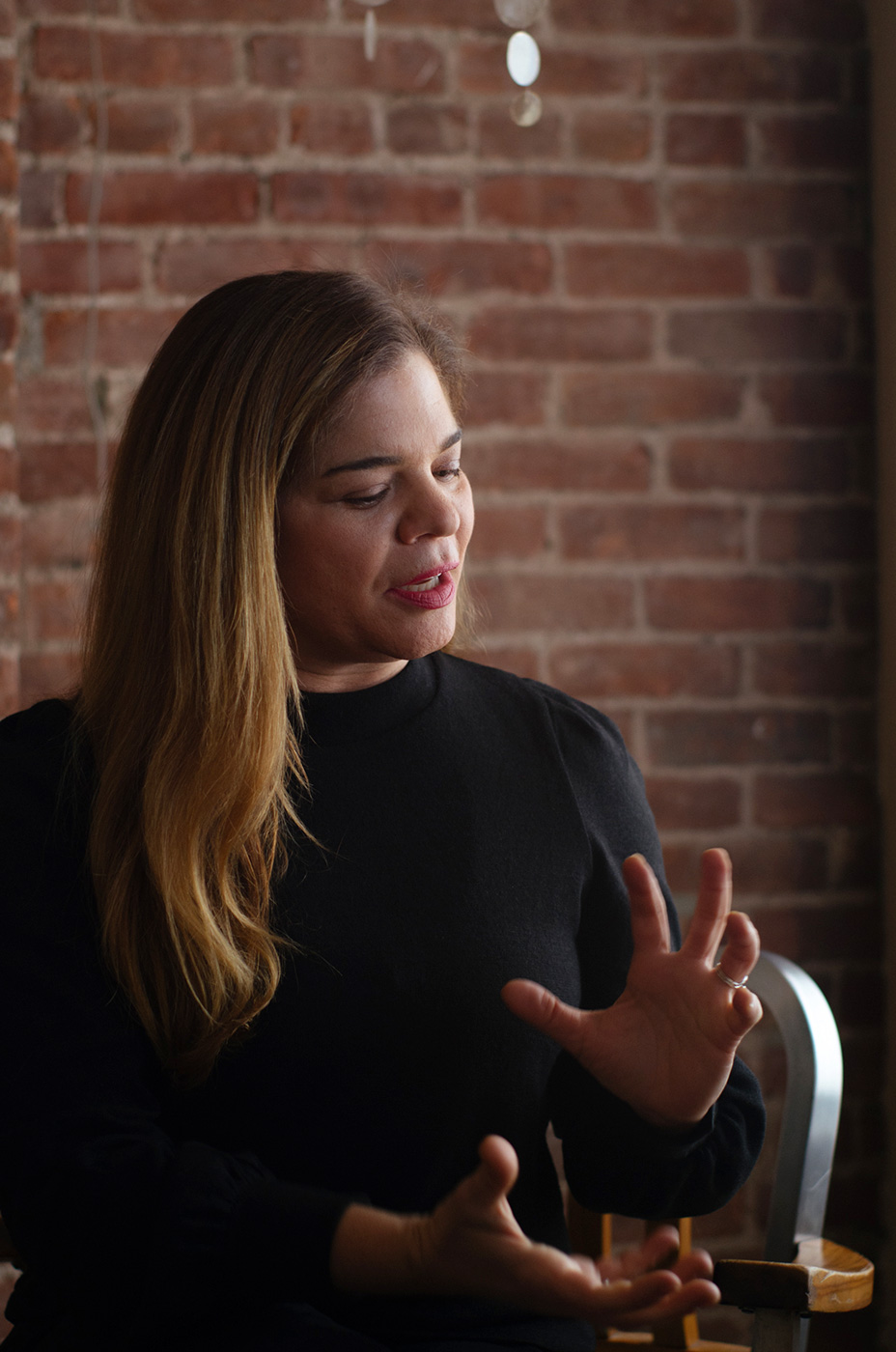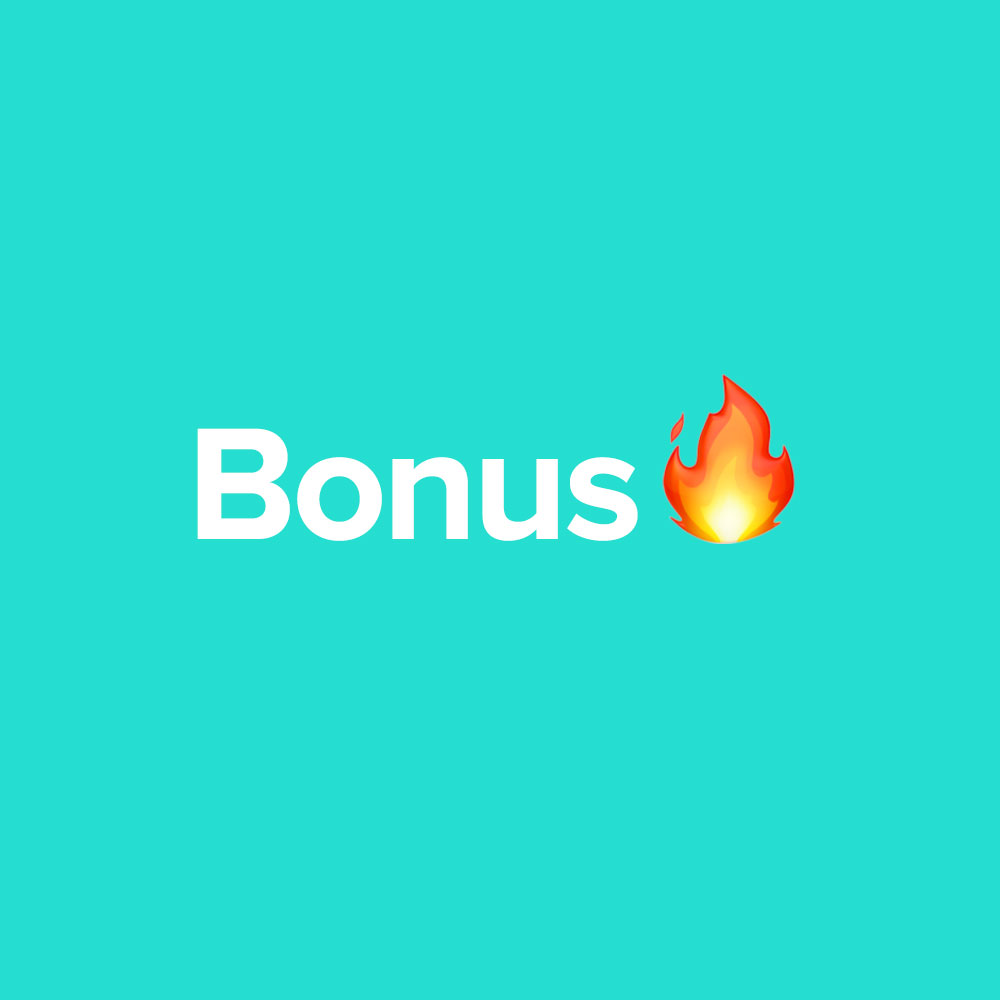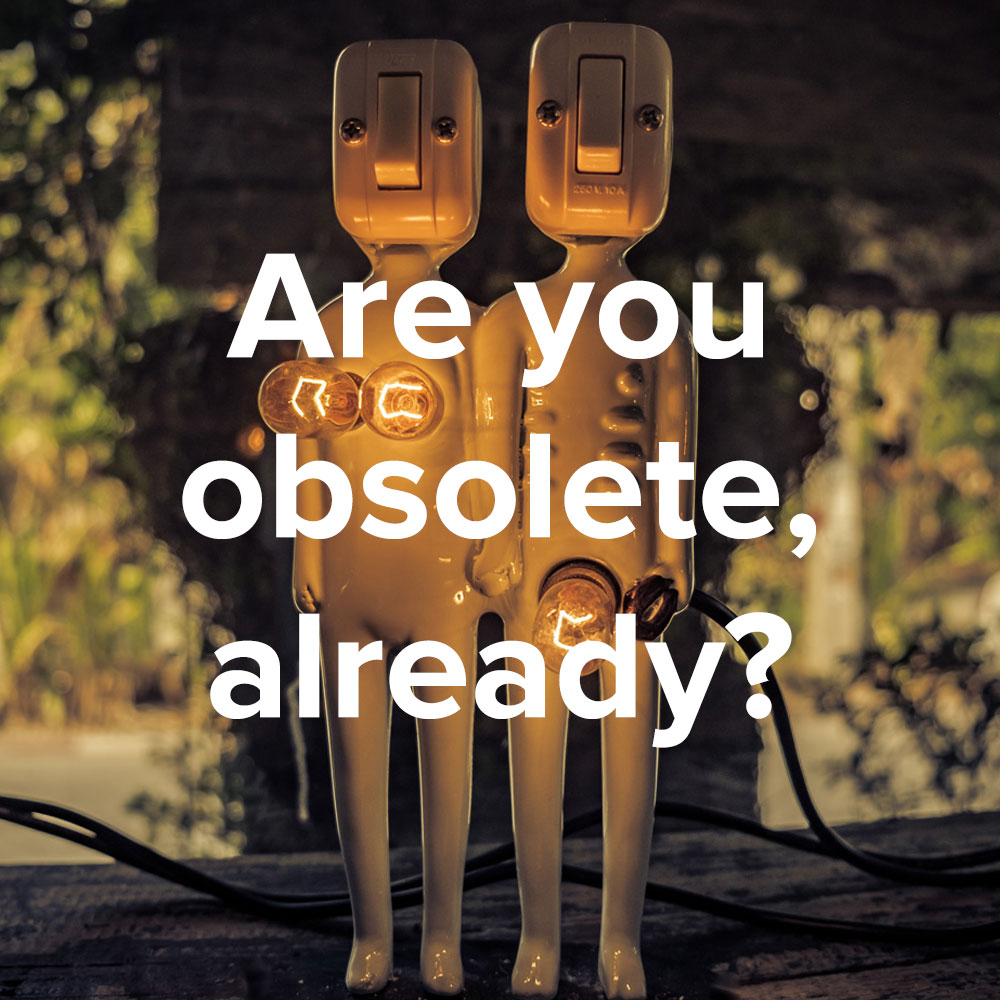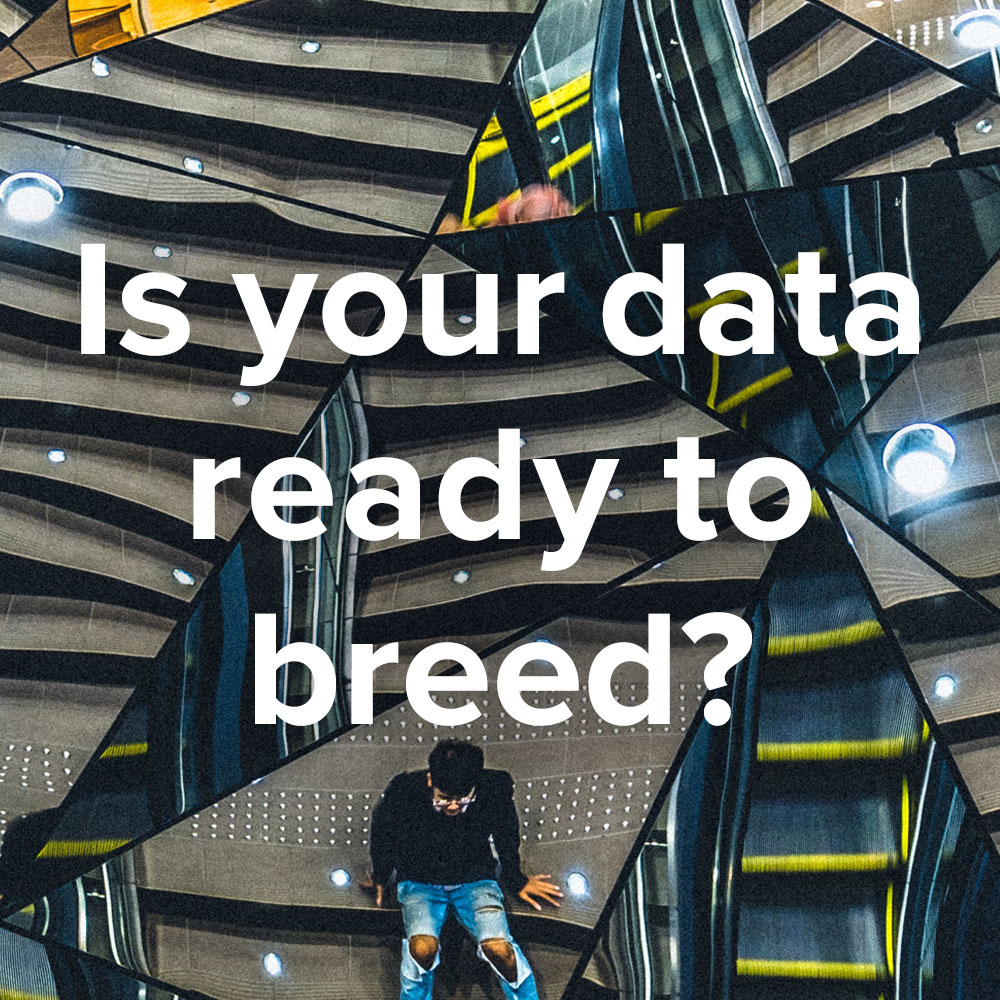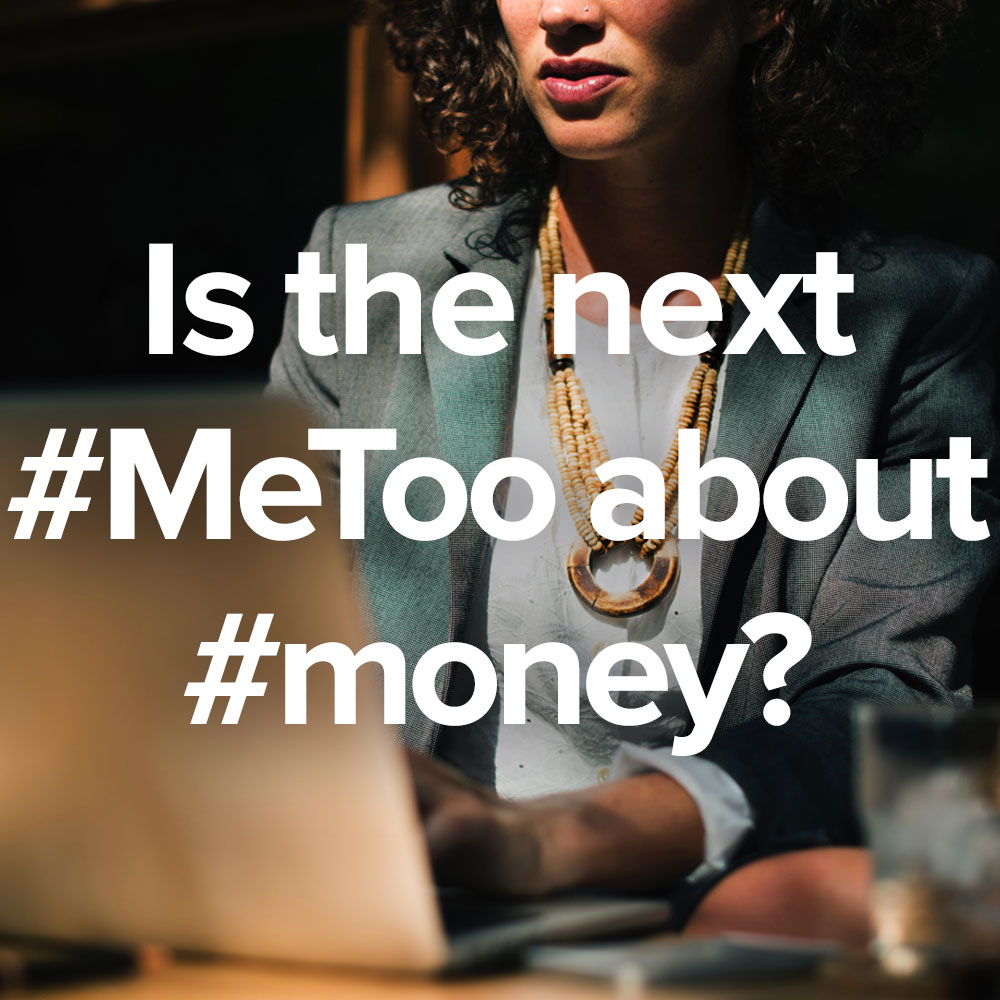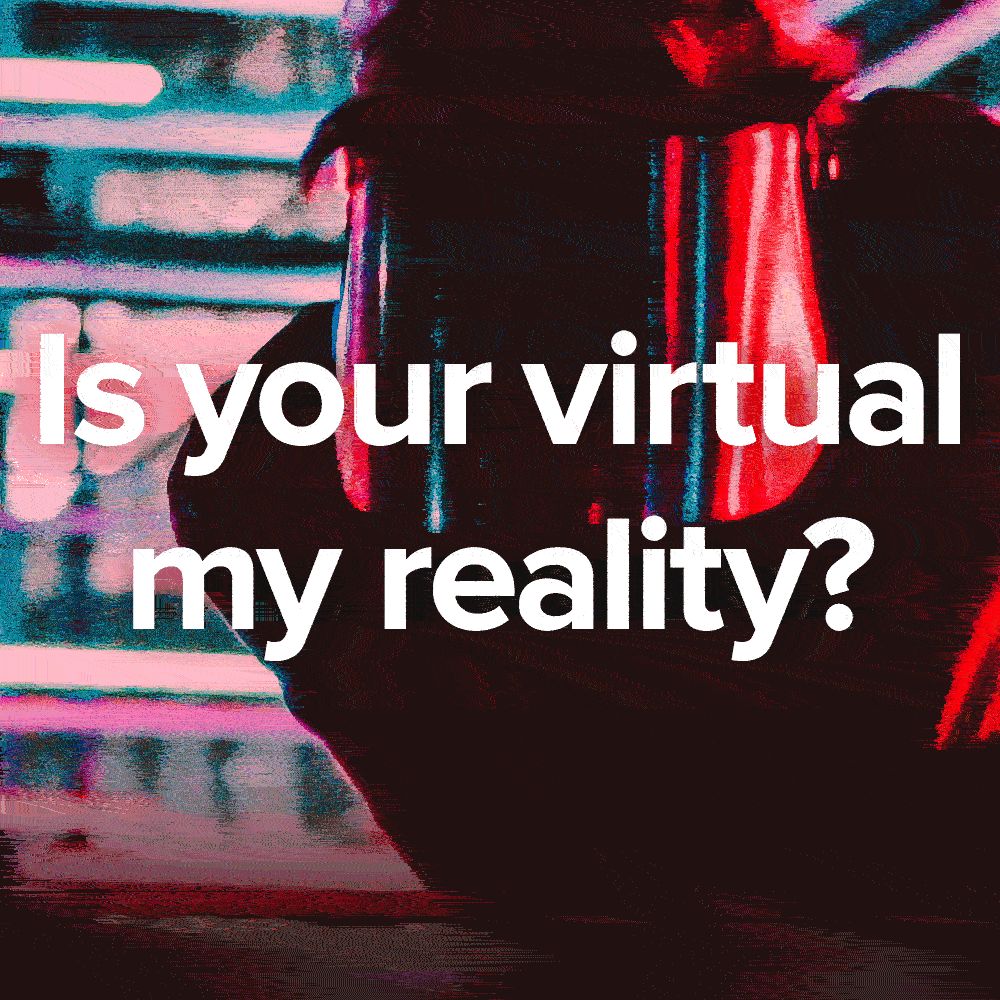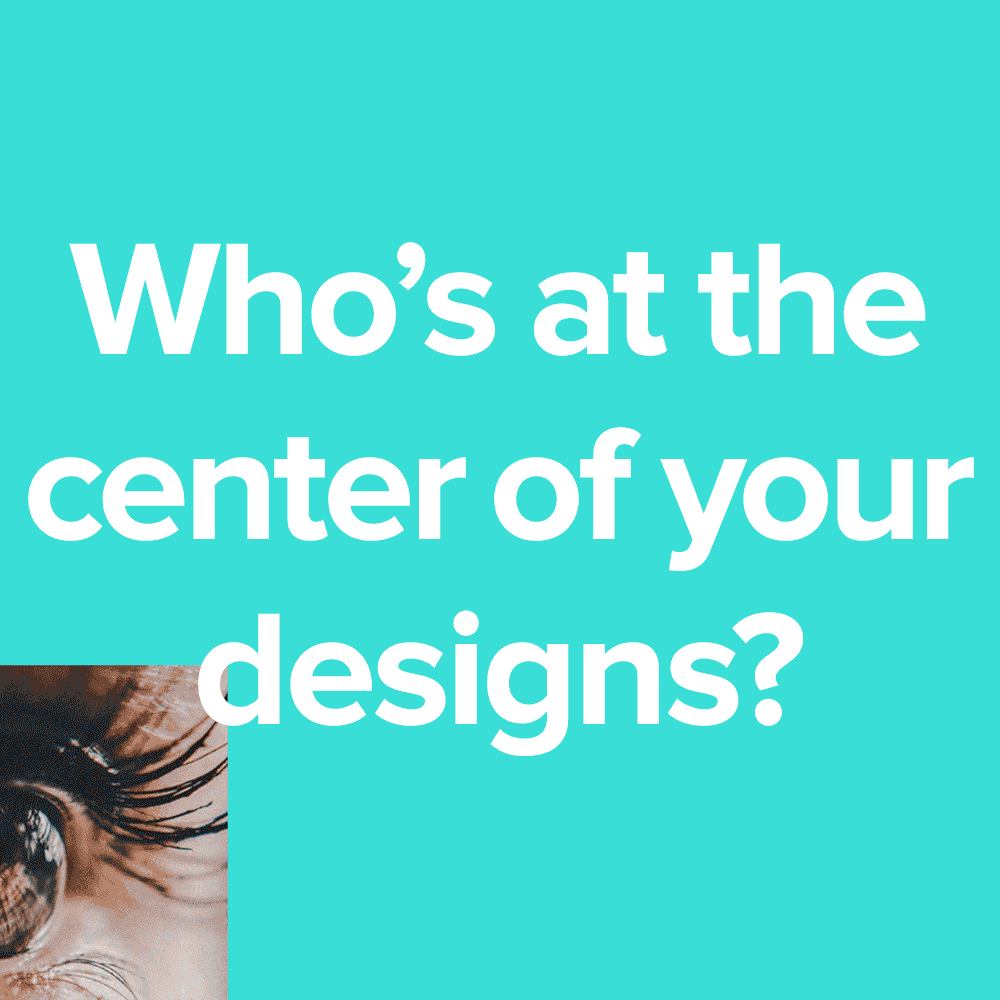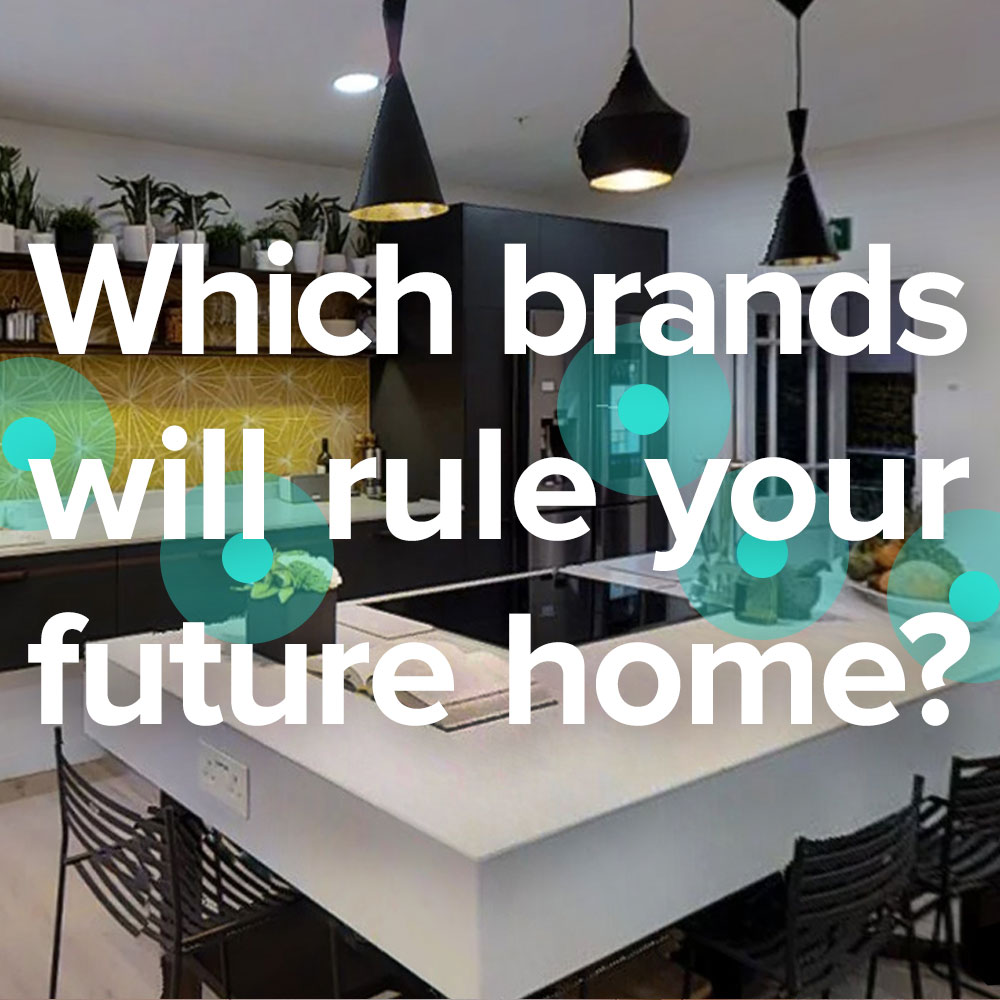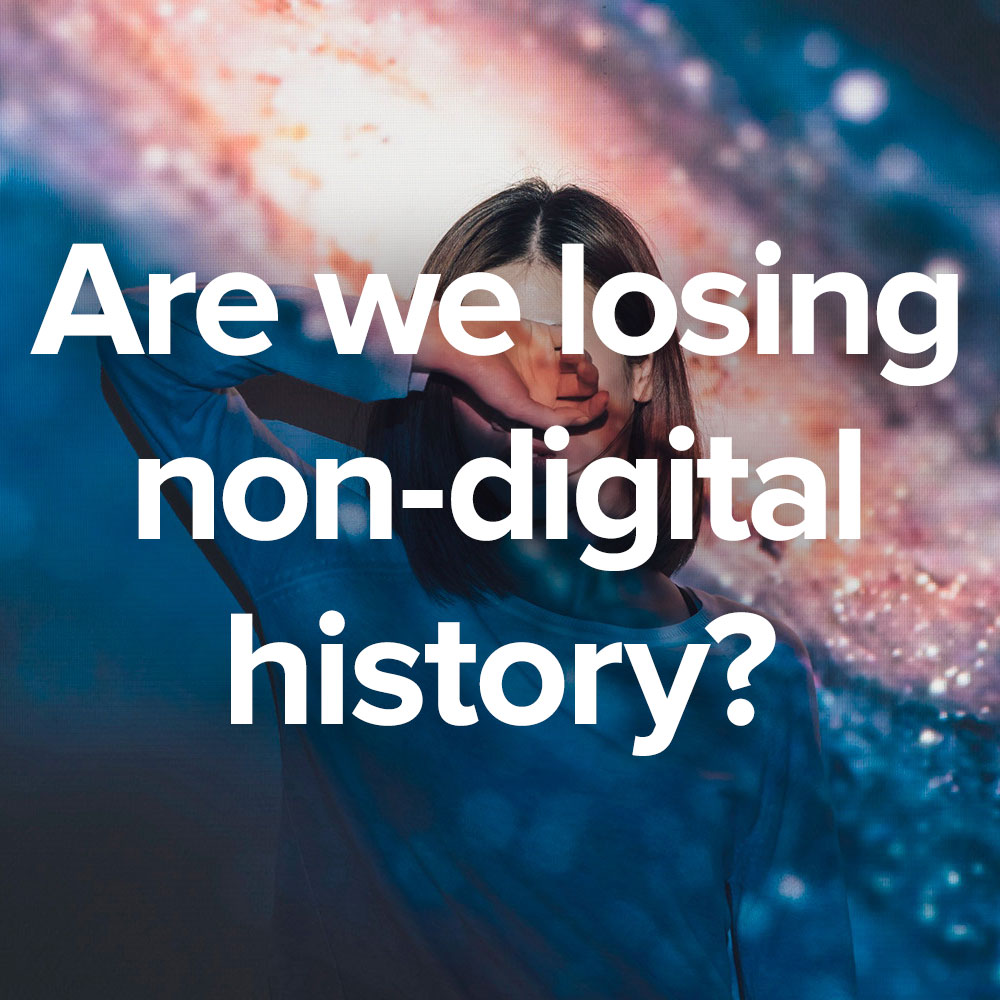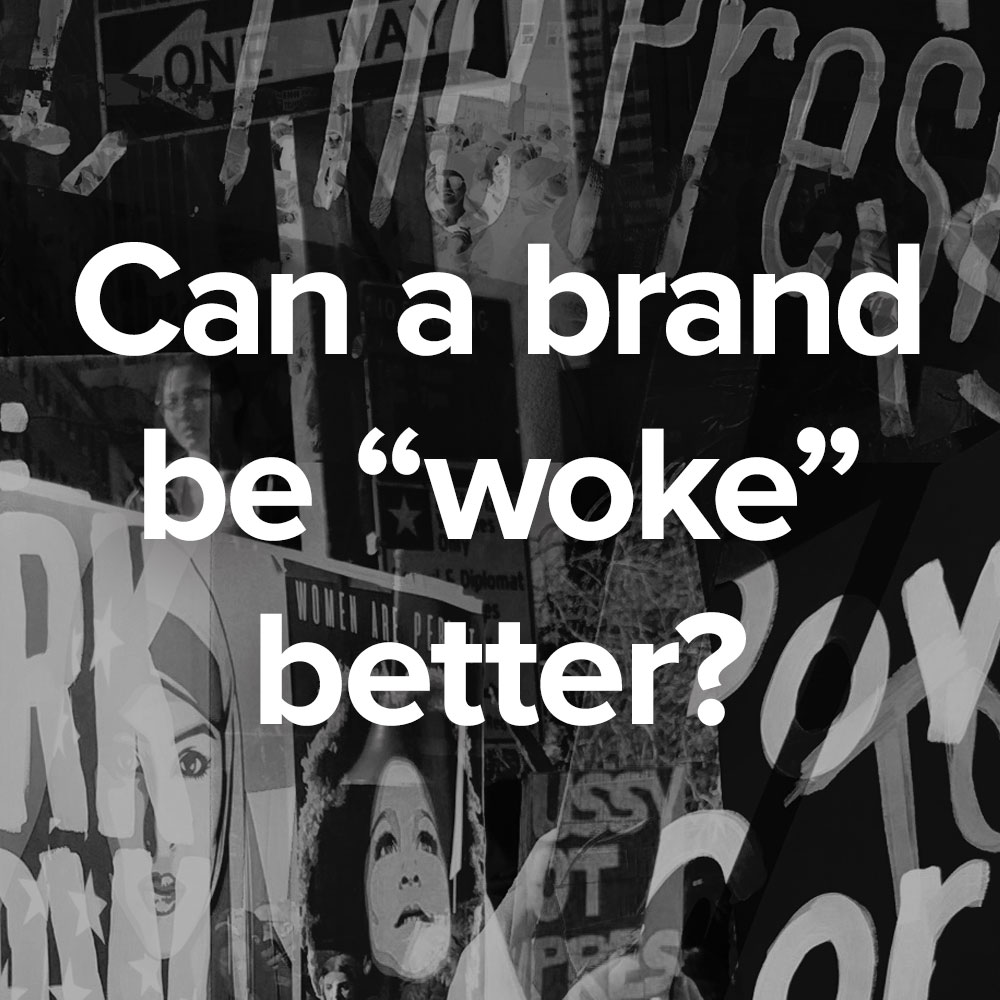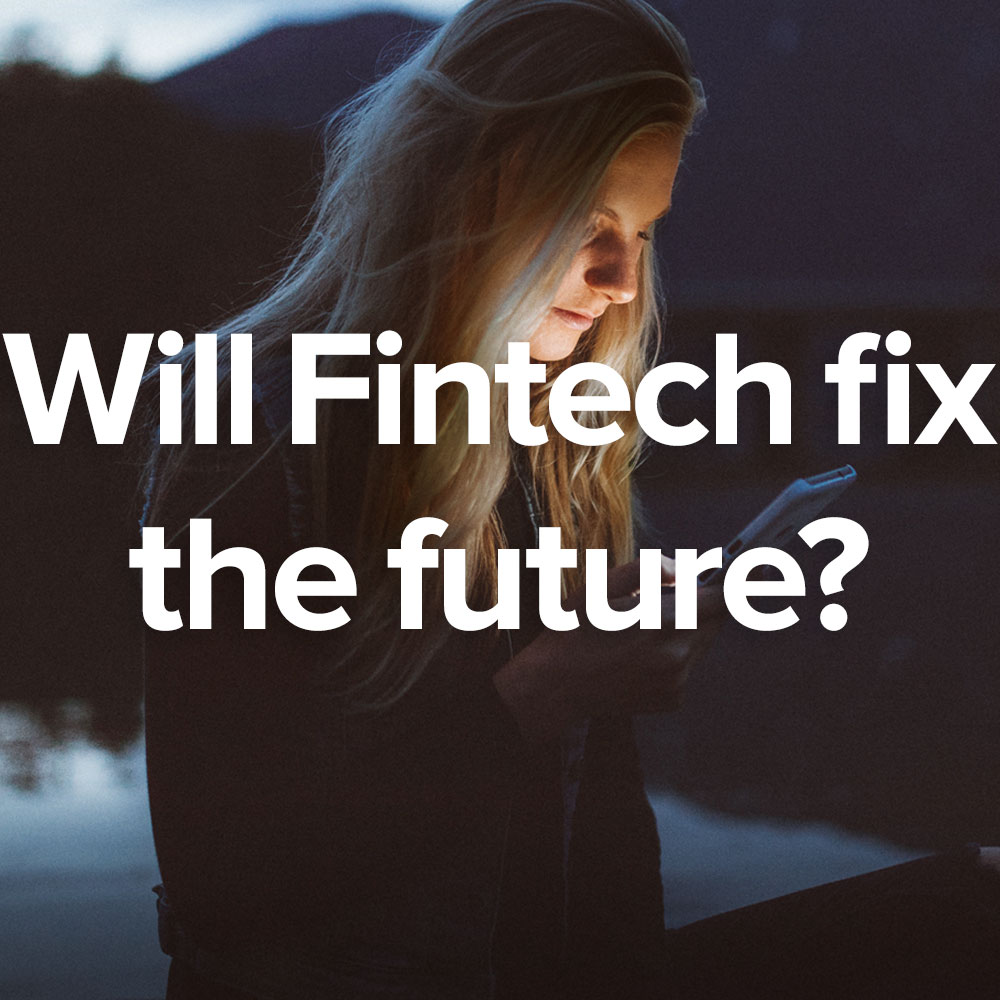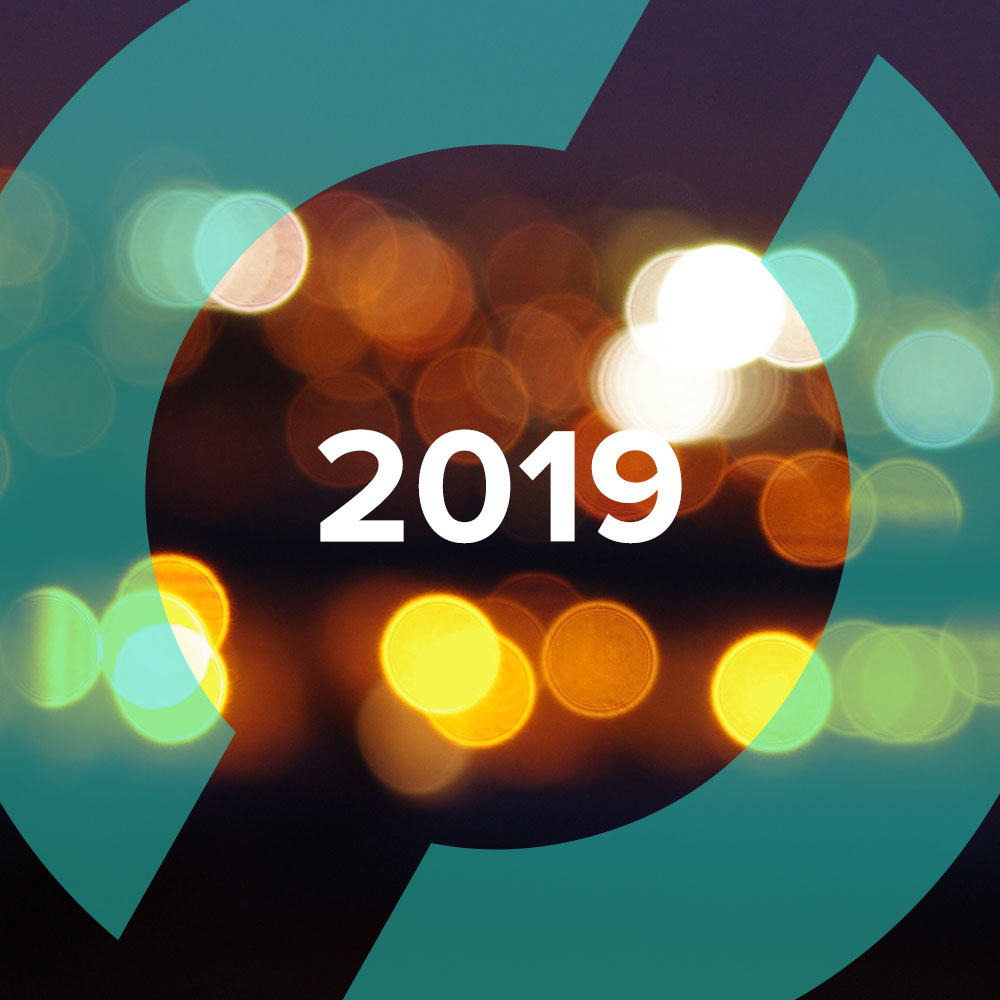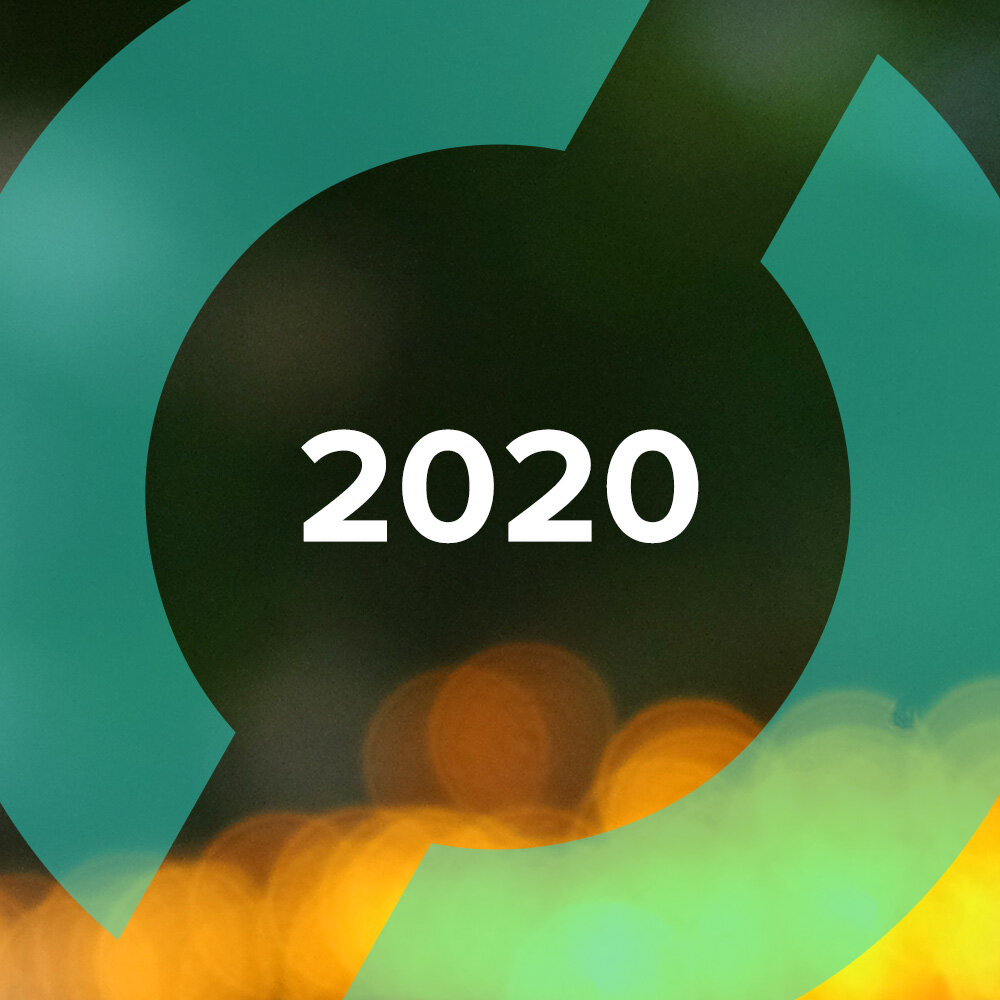“_________”
Belinda on Audio Marketing.
Our goal is to uncover insights that allow unique stories to come to life, I think that’s the magic, you know.
— Belinda Lopez Sturtevant
Global Director of Integrated Production at Spotify
— It’s said that we form our musical tastes early on—for life. We can pretend later that we’re really into jazz or chamber music, but it turns out nothing will ever move us the way the Beatles’ “Something” moved me in October 1969, or Drake’s “God’s Plan” moved kids this year, even if we were too young to get the song (at all, in my own case). For the record, I was only eight years old in 1969, so there was still some wiggle room. I filled it with bubble gum, glam rock, punk, and that guy from the Jersey Shore, more or less in that order.
Earlier this month, Spotify, the music-subscription service, tabulated data about my current listening habits. In a very pleasant and creative way, Spotify shared the numbers back with me online (this is Spotify’s 2018 Wrapped campaign). The personalized interactive 2018 Wrapped experience is awesome. Turns out I had spent 22,074 minutes on the service this year, 600 of those—the most—with Sarah Shook & the Disarmers. I had listened to non-mainstream artists 104% more than the average Spotify listener. Spotify Wrapped is a fun and, even better, personal marketing campaign.
Belinda Lopez, Director of Integrated Production at Spotify and a member of its award-winning in-house agency, recently explained how it all comes together. She also (you have to read to the end, no cheating) dished her top four songs for New Year’s Eve. As I write this final OPEN Topics of 2018, I am familiar with one of them (everybody is), but not the other three. New Year’s Eve in Nashville, I’ll be listening to Belinda’s faves, expanding my cultural horizons. In New York’s Chinatown, Todd will tune in, as will Chloe across the river in Bushwick, Brooklyn. Mia, many hours ahead of us in Hamburg, Germany, will certainly have her headphones on. Happy New Year, everybody.
Belinda, what does a “Director of Integrated Production” do at Spotify? What does that mean? How did you end up there?
Belinda — I began my advertising career in creative management, which allowed me to gain a true understanding of all of the roles within an agency structure. I transitioned into production and gained most of my experience by taking on complex projects, mostly within digital agencies, which allowed me to explore unique approaches to storytelling. When I arrived at Spotify over two years ago, I was the first integrated in-house producer; I was tasked with a wide variety of projects across various mediums. I now manage a team of producers that come from a variety of different backgrounds, which is essential, as they each bring a different set of experiences. The production department works closely with the creative department through to final execution, it’s a very collaborative process.
Is there anything special about your producers, a defining characteristic?
Producers that I bring in may also be filmmakers, or maybe they are illustrators. There’s always a real sense of creativity and curiosity with all of the producers on the team; my goal is to push them outside of their comfort zone, which allows them to always feel challenged. Overall, the most important characteristics I look for in a producer are a positive attitude, open-mindedness, and the ability to figure things out.
Build an idea for me at Spotify. Who comes up with the germ of the idea, and how does it go from there to a diverse global audience, and how long does that take, by the way? Six months, a year and a half?
We have a conceptual creative team. Our conceptual creative team and group of designers work with our strategy department. We then work with different parts of the organization, whether it be content and artist marketing, the premium service, the free one. (We launched a whole new free experience this year.) They brief us on an idea. We collaborate closely but, essentially, our branding creative team will work to really develop the idea and be able to figure out a concept that is going to work. In the sense that there’s so much information that is needed to be able to arrive at that concept, there’s an enormous collaboration with different parts of the organization.
You localize your global campaigns, like with Spotify Wrapped, right? Is that a lot of work? How much time does that take?
Yes, it’s an enormous amount of work and the way that we work is so quick. It’s at such a rapid scale that I feel like the only way that we can work effectively is to build something in-house. One, there’s just an enormous amount of data, and pulling insights to be able to tell unique stories for each of the users is one portion of it. Then making sure that it resonates across multiple markets, and making sure that it’s something that’s compelling for users around the world, and then being able to tell the stories and localize them.
In the last year, we have started to work with agencies in local markets, but the Wrapped site experience was something that was fully produced in-house just because that’s the way digital production works. What we do is we have concepts, we have a toolkit that we provide for all of the different markets, and they localize with their agencies.
“Being able to translate something and then transcreate to that local market is very nuanced, and it’s been a huge learning for me. Just being able to adapt your thinking in a way that, for example, is this too culturally one-sided? You have to really have a world view of who your users are.”
Messages are messages, but you must run into language difficulties now and then?
Being able to translate something and then transcreate to that local market is very nuanced, and it’s been a huge learning for me. Just being able to adapt your thinking in a way that, for example, is this too culturally one-sided? You have to really kind of have a world view of who your users are.
Other cultures have customs, even numerical superstitions, that someone sitting in New York probably wouldn’t know about. How do you protect against the downside of that?
Well, we work really closely with each market. Each market has a team that’s dedicated to working with us on making sure that the translations are correct and that, if there’s a nuance in an English phrase, that they can adapt that in their language. We work really closely with each of the markets to make sure that everything is localized in a way that feels really authentic to that country.
With Wrapped, were there any specific challenges that you guys were like, “Whoa! Okay,” and if so, how did you work through them?
This is my third year working on the Wrapped campaign and we keep building off of it every year. The idea originated in 2015 with the “Year in Music” campaign, which we followed with “Thanks 2016, It’s Been Weird.” In 2017, rather than looking back, we decided to focus on the year ahead with “2018 Goals.”
2018 Wrapped is based on our user’s listening habits, of course, but this year we focused on user-created playlists mostly based on cultural trends. When we really began to dig into that, we just started to have a lot of fun with it; it’s something that has now created anticipation.
You guys won the Ad Age House Agency of the Year. I know this sounds like after the Super Bowl, but what did winning that mean to you?
I feel really blessed to be a part of a truly special team and be able to create work we all believe.
Honestly, I’ve been in this industry for such a long period of time. And having a vision of what it is to collaborate and bring a creative story to life without watering it down or whittling it down, and be able to be brave and do things that are very, very different than the traditional way of bringing a story or an experience to life, and having that be acknowledged, is just really, really powerful. The team that I work closely with is always wanting to push creativity to a new way of storytelling. Having that resonate with an audience and resonate within our industry just brought a lot of satisfaction, personally.
“We work really, really fast. Insanely fast. ... If you actually miss the moment, you just have to move on.”
Let’s talk a little about music and marketing. How do you stay on top of things?
You have to truly love what you do, because it’s a very competitive industry. You have to stay connected at all times or you risk missing a big cultural moment.
To be very honest with you, we work really, really fast. Insanely fast. If you’re looking at the brief or an idea that comes to life, we are an in-house team, and we’re really connected with all of our stakeholders and our partners. If you actually miss the moment, you just have to move on because I feel like the world evolves so quickly. Social media, obviously, culturally relevant moments, music. We have to be there in that present moment, able to create stories or campaigns that are culturally relevant.
David Bowie, New York City, the subway, tell me about that. You definitely pushed the envelope there in terms of innovation.
Along with the Brooklyn Museum exhibit we wanted to create a special tribute to showcase David Bowie and his relationship with the city. To do this, we took over his local subway station, Broadway-Lafayette, and transformed it into a temporary museum exhibit. The exhibit explored his influence on music, fashion, culture, and the city he loved.
However, we had always been tinkering with being experimental with out-of-home, but this brought the out-of home experience to life in a completely unique way. I had always been tinkering with that, you know? It’s just always something like, “How do we take a space? What can we possibly do?” When we had the opportunity to do something unique with David Bowie, the media team was able to quickly start to locate different parts of the city that were really important and significant to him. Just knowing that that was his neighborhood, and being able to have the entire space to be able to create work, we worked really closely with our media team to push the experience into all these different aspects within the subway platform that had never been done before.
I think that’s something where the stem of the idea was always there. How do I figure out a way to really push an out-of-home experience and almost bring a museum-esque quality to a public space within New York? It’s a matter of everything falling into place. It was the right artist, it was the right time, it just felt significant. As a producer, you’re always thinking about the medium and the platform and what new and interesting ways you can experiment with it, but the story, the moment just have to come together and feel like it’s the right time.
As long as we’re talking about subways, I saw this photo online of a Spotify ad in the New York City subway system featuring Halsey. It’s a pretty generic-looking subway station, you can't immediately tell which stop it is. And I was wondering, did you happen to put that ad up at the Halsey St. station on the L line? That was my stop. It's never looked that clean.
I’d have to see what image you’re referencing, but we always make sure to personalize every creative execution to maintain relevancy.
Authenticity is a factor in your thinking.
Authenticity is really one of the pillars if you want to be culturally relevant with users, because we have true music fans. Most of us are very aware of when a brand is trying too hard, you have to be true to the brand in everything you create.
We know Spotify can offer brands data that go way beyond demographics and devices to reflect moods, moments, and mindsets. How do you leverage that specifically for in-house concepts and campaigns?
There’s a lot of different moods and a lot of different things that people personalize within a playlist, so that stems an enormous amount of curiosity for us with our users. I think that allows discovery.
With that, there’s an enormous amount of data that we’re able to receive, but it’s really about pulling insights from that data. The magic is being able to pull insights that allow the storytelling to really come to life. I think that’s the magic, you know? There’s an enormous amount of the ability to pull stories that not everyone would notice right off the bat.
As a data collector, how do you avoid offending people?
We are very conscious of the fact that people are sensitive about their data, and we’re very considerate of that. We are using data in a positive way to bring unique stories to life and celebrate our users.
One of the really unique things that we did this year for Spotify Wrapped is allowing users, after they were able to see all of their data for the year, to opt in to have their ‘share card’ on a massive billboard in Times Square. We did that across a variety of different markets. France, the United Kingdom, Canada, Australia, Germany, users were able to opt in and have all of their information and their share card celebrated on a billboard this year, so that’s kind of fun. Taking it to the next level.
Cool. I opted in.
Oh, that’s great to hear!
Which actually surprised me. But anyway. With Wrapped, did Spotify reach out to partner with any artists, or were they considered users like everyone else?
Artists wanted to celebrate and thank their users. One of the things that we have is a really unique dialogue between fans and artists. I think fans are enormously devoted to following these artists, supporting them, and I think the community is really, really strong in that way. I was shocked by how many artists shared and thanked their fans, and it really says a lot about the brand as a whole. I think that the authenticity, the conversation, the ability to live in this community, of being able to support each other and support the artists in whatever campaign or project that we work on, I think that resonates with the artists and it’s lovely to see how many of them shared. That’s completely on their own. We knew some artists would share, but the number of artists that shared this year was above and beyond expectations, so we’re really happy about that.
“With Wrapped, artists wanted to celebrate and thank their fans. I think fans are enormously devoted to following and supporting their top artists, and I think the community is really, really strong in that way.”
New Year’s Eve is fast approaching. Keith Urban and Peter Frampton are headlining a festival here in Nashville. Interesting mix. What will you be listening to?
I really feel like this year, I am going to be listening to Latin music. Reggaeton, Merengue, or Salsa. I’m Cuban and Dominican and I’m going to be with my family, so “Despacito” ...
Justin Bieber version or just Luis Fonsi and Daddy Yankee?
Oh, Luis Fonsi and Daddy Yankee for sure.
What else?
“Candela” by Buena Vista Social Club. “Quimbara” by Celia Cruz. “Que Bueno Baila Usted” by Beny Moré. I will be in Miami, so you can expect a lot of dancing!
Thank you Belinda and enjoy Miami!


